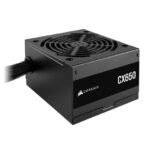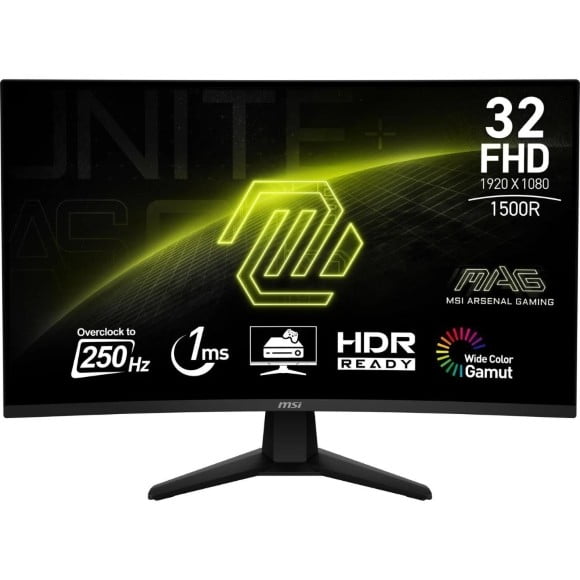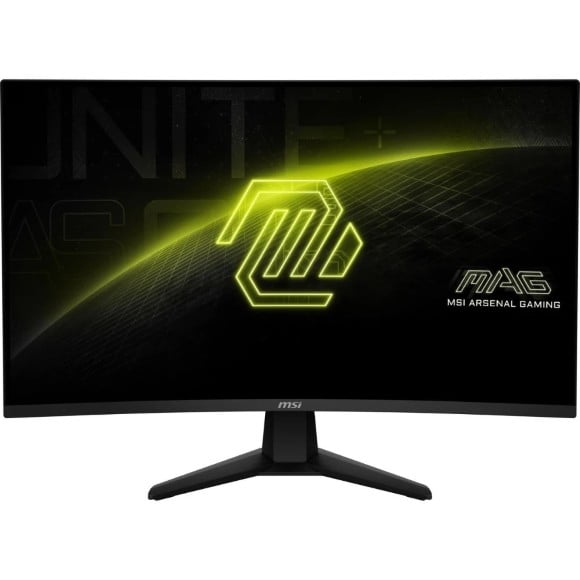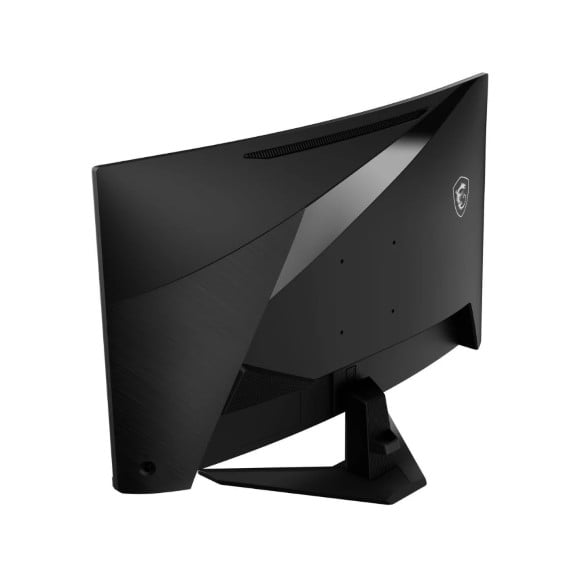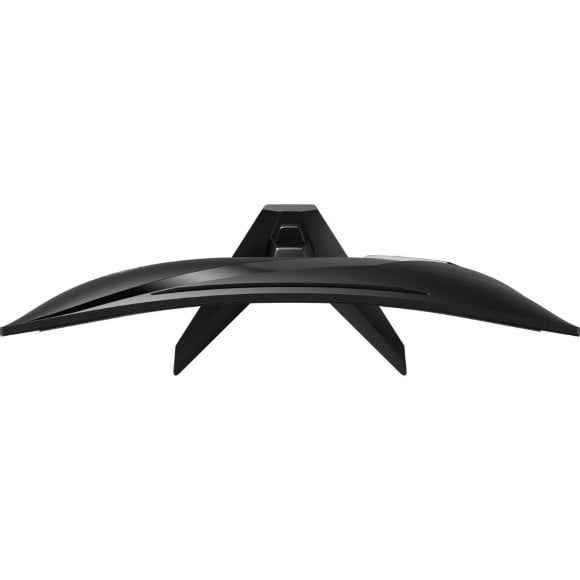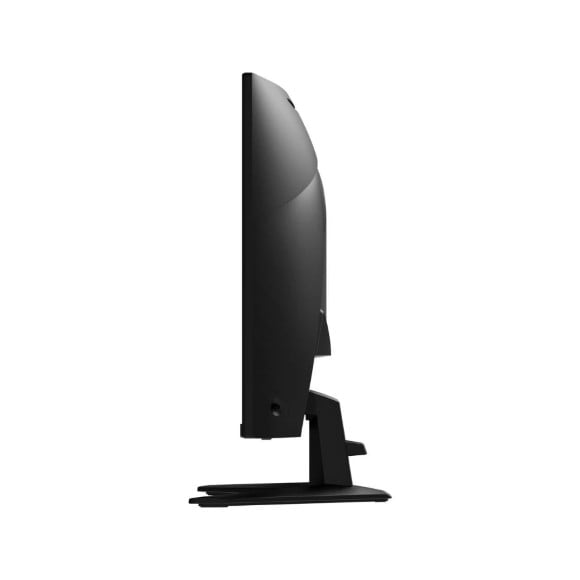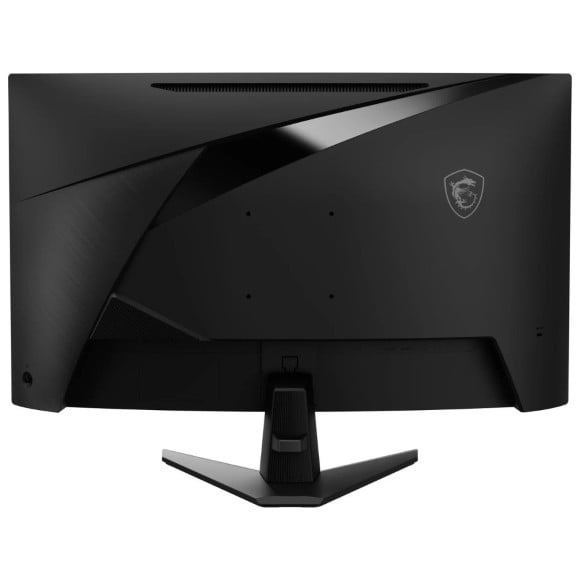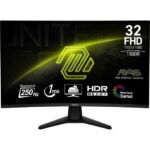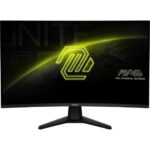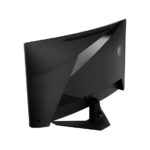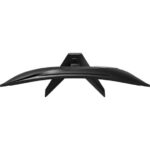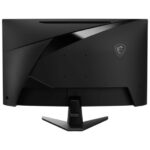MSI MAG 32C6X 250Hz (OC) VA FHD Gaming Monitor Price in Pakistan
| Brand
Name of the company-manufacturer. |
MSI |
| Model
Designation of the model. |
MAG 32C6X |
| Model alias
Other known designations of the model. |
MAG32C6X |
| Model year
The year in which this model was announced. |
2024 |
Display
Information about the main characteristics of the display – panel, backlight, resolution, refresh rate, etc.
| Size class
Size class of the display as declared by the manufacturer. Often this is the rounded value of the actual size of the diagonal in inches. |
31.5 in (inches) |
| Diagonal
Approximate diagonal size of the display. If the manufacturer does not provide such information, the diagonal is calculated from the width and height of the screen. |
800.1 mm (millimeters) 80.01 cm (centimeters) 31.5 in (inches) 2.625 ft (feet) |
| Width
Approximate width of the display. If the manufacturer does not provide such information, the width is calculated from the diagonal and the aspect ratio. |
698.4 mm (millimeters) 69.84 cm (centimeters) 27.4961 in (inches) 2.2913 ft (feet) |
| Height
Approximate height of the display. If the manufacturer does not provide such information, the height is calculated from the diagonal and the aspect ratio. |
392.85 mm (millimeters) 39.285 cm (centimeters) 15.4665 in (inches) 1.2889 ft (feet) |
| Radius of curvature
There are curved displays, whose curve is part of a circumference (arc). In order to give more precise information about the curve of the screen, often the manufacturer provides data about the radius of this circumference. The smaller the radius, the larger the screen curve. |
1500 mm (millimeters) 150 cm (centimeters) 59.0551 in (inches) 4.9213 ft (feet) |
| Panel type
There are various panel technologies. Each has its own specific features – viewing angles, color reproduction, response time, brightness/contrast, production cost, etc. The image quality depends directly on the type of the display panel used. |
VA |
| Panel bit depth
The most widely used panels are those with 6, 8, and 10 bits for each of the RGB components of the pixel. They provide 18-, 24-, and 30-bit color, respectively. |
10 bits (8 bits + FRC) |
| FRC
Frame Rate Control (FRC) is a method, which allows the pixels to show more color tones. With quick cyclic switching between different color tones, an illusion for a new intermediate color tone is created. For example, by using FRC, a 6-bit display panel is able to show 16.7 millioin colors, which are typical for 8-bit display panels, and not the standard 262200 colors, instead. There are different FRC algorithms. |
Yes |
| Colors
The maximum number of colors, which the display is able to reproduce, depends on the type of the panel in use and color enhancing technologies like FRC. |
1073741824 colors 30 bits |
| Aspect ratio
The ratio between the horizontal and the vertical side of the display. Some of the standard and widely used aspect ratios are 4:3, 5:4, 16:9 and 16:10. |
1.778:1 16:9 |
| Resolution
Information about the number of pixels on the horizontal and vertical side of the screen. A higher resolution allows the display of a more detailed and of higher quality image. |
1920 x 1080 pixels Full HD / 1080p |
| Pixel pitch
The pixel pitch shows the distance from the centers of two neighboring pixels. In displays, which have a native resolution (the TFT ones, for example), the pixel pitch depends on the resolution and the size of the screen. |
0.364 mm (millimeters) 0.0364 cm (centimeters) 0.0143 in (inches) 0.0012 ft (feet) |
| Pixel density
Information of the number of pixels in a unit of length. With the decrease of the display size and the increase of its resolution, the pixel density increases. |
69 ppi (pixels per inch) 27 ppcm (pixels per centimeter) |
| Display area
The percentage of the approximate area, taken by the active part of the screen, to the total front area. |
92.28 % (percent) |
| Backlight
The backlight is the source of light of the LCD display panels. The type of backlight determines the image quality and the color space of the display. There are various backlights such as CCFL, LED, WLED, RGB-LED, and etc. |
W-LED |
| sRGB
sRGB is a color space, developed jointly by Hewlett-Packard and Microsoft in 1996. It is used in different devices such as printers, displays, TV sets, cameras, etc. The sRGB color space covers about 72% of the NTSC color space. |
101 % (percent) |
| Adobe RGB (1998)
Adobe RGB (1998) is a color space, developed by Adobe Systems in 1998. It has a wider gamut than the sRGB (mainly in the cyan-green range of colors) and is widely used in professional printing. |
81 % (percent) |
| DCI P3
DCI P3 is a color space, introduced in 2007 by the SMPTE. It is used in digital cinema and has a much wider gamut than the sRGB. |
78 % (percent) |
| Brightness
Information about the brightness of the screen. It is measured in candela per square metre (cd/m²). |
250 cd/m² (candela per square meter) |
| Static contrast
The static contrast shows the ratio between the brightest and the darkest color, which the display can reproduce simultaneously, for example, within one and the same frame/scene. |
3000 : 1 |
| Dynamic contrast
The dynamic contrast shows the ratio between the brightest and the darkest color, which the display can reproduce over time, for example, in the course of playing a video. |
100000000 : 1 |
| Horizontal viewing angle
Information about the maximum horizontal viewing angle, within which the image on the screen is of acceptable quality. |
178 ° (degrees) |
| Vertical viewing angle
Information about the maximum vertical viewing angle, within which the image on the screen is of acceptable quality. |
178 ° (degrees) |
| Coating
Information about the type of coating of the display. There are different types of matte and glossy coatings, each of which has its own advantages and drawbacks. |
Anti-glare/Matte |
| Response time – 1 ms (MPRT – Motion Picture Response Time) |
3D
3D displays use various technologies to achieve a 3D effect. Each of these technologies has its own advantages and drawbacks.
| 3D
Information on whether 3D is supported or not. |
No |
Frequencies
Information about the horizontal and vertical refresh rates/frequencies.
| Horizontal frequency (digital)
The horizontal scan rate/frequency shows the number of horizontal lines, displayed by the monitor per second, when it is plugged to a digital source. |
52.7 kHz – 1125 kHz (kilohertz) |
| Vertical frequency (digital)
The vertical frequency/refresh rate shows how many times in a second the image on the screen is refreshed. |
48 Hz – 250 Hz (hertz) |
| Overclock – 250 Hz |
Power supply and consumption
Information about the power supply and consumption, energy efficiency class, etc.
| 110V
Permissible voltage tolerance in a 110-volt electric system. |
100 V – 120 V (volts) |
| 220V
Permissible voltage tolerance in a 220-volt electric system. |
220 V – 240 V (volts) |
| Alternating current frequency
Requirement regarding the alternating current frequency in the electric system. |
50 Hz – 60 Hz (hertz) |
| Power consumption (sleep)
Power consumption in sleep/stand by/suspend mode. |
0.5 W (watts) |
| Power consumption (average)
Average power consumption in standard work mode. |
26 W (watts) |
| Power consumption (maximum)
The maximum possible power consumption. |
33 W (watts) |
| Energy efficiency class
The energy efficiency class/label provides general idea about the power consumption. There are different energy efficiency classes and each sets its own requirements regarding the power consumption. Some of the existent energy efficiency classes are A+++, A++, A+, A, B, C, D, E, F, G. |
Е |
Dimensions, weight and color
Information about the dimensions and the weight of the specific model with and without stand as well as the colors, in which it is offered to the market.
| Width
Width without stand in different measurement units. |
709.4 mm (millimeters) 70.94 cm (centimeters) 27.9291 in (inches) 2.3274 ft (feet) |
| Height
Height without stand in different measurement units. |
419.1 mm (millimeters) 41.91 cm (centimeters) 16.5 in (inches) 1.375 ft (feet) |
| Depth
Depth without stand in different measurement units. |
107.2 mm (millimeters) 10.72 cm (centimeters) 4.2205 in (inches) 0.3517 ft (feet) |
| Weight
Weight without stand in different measurement units. |
4.9 kg (kilograms) 10.8 lbs (pounds) |
| Width with stand
Width with stand in different measurement units. |
709.4 mm (millimeters) 70.94 cm (centimeters) 27.9291 in (inches) 2.3274 ft (feet) |
| Height with stand
Height with stand in different measurement units. |
507.2 mm (millimeters) 50.72 cm (centimeters) 19.9685 in (inches) 1.664 ft (feet) |
| Depth with stand
Depth with stand in different measurement units. |
249.8 mm (millimeters) 24.98 cm (centimeters) 9.8346 in (inches) 0.8196 ft (feet) |
| Weight with stand
Weight with stand in different measurement units. |
5.4 kg (kilograms) 11.9 lbs (pounds) |
| Box width
Width of the package in different measurement units. |
800 mm (millimeters) 80 cm (centimeters) 31.4961 in (inches) 2.6247 ft (feet) |
| Box height
Height of the package in different measurement units. |
514 mm (millimeters) 51.4 cm (centimeters) 20.2362 in (inches) 1.6864 ft (feet) |
| Box depth
Depth of the package in different measurement units. |
170 mm (millimeters) 17 cm (centimeters) 6.6929 in (inches) 0.5577 ft (feet) |
| Box weight
Weight of the product with all accessories and packaging in different measurement units. |
8.5 kg (kilograms) 18.74 lbs (pounds) |
| Stand depth
Depth of the stand in different measurement units. |
249.8 mm (millimeters) 24.98 cm (centimeters) 9.8346 in (inches) 0.8196 ft (feet) |
| Colors
Information about the colors, in which the specific model is offered to the market. |
Black |
Ergonomics
Information about the ergonomic functions – height adjustment, swivel angles, tilt angles, etc.
| VESA mount
Information about whether there is a possibility for wall mounting according to the VESA Mounting Interface Standard (MIS). |
Yes |
| VESA interface
There are many various interfaces under the VESA standard, which differ in the size of the brackets, the distances between the screw holes and their number. |
100 x 100 mm |
| Removable stand
Information about whether the stand can be dismounted. Usually, this is required for wall mounting. |
Yes |
| Height adjustment
Information about whether the stand allows height adjustment. |
No |
| Landscape/portrait pivot
Some displays have the ability to operate in landscape and portrait mode alike. |
No |
| Left/right swivel
Information whether the display can be swiveled around the stand axis. |
No |
| Forward/backward tilt
Most displays have the ability to be tilted forward and backward as to provide a more comfortable viewing position for the user. |
Yes |
| Forward tilt
Maximum degree of forward tilting of the display. |
5 ° (degrees) |
| Backward tilt
Maximum degree of backward tilting of the display. |
20 ° (degrees) |
Camera
Many contemporary desktop monitors and smart TV sets have built-in cameras.
| Camera
Information whether the current model has a built-in camera or not. |
No |
Connectivity
Available connectivity ports, slots and interfaces.
| Connectivity
Information about the available connectivity ports, slots and interfaces such as USB, infrared port, SD card slot, audio/video and network interfaces, etc. |
2 x HDMI 2.0 1 x DisplayPort 1.4 1 x 3.5 mm Audio Out |
Features
Some additional functional features of the model.
| Features
Information about additional software features, technologies, functions and services of the model. |
Adaptive-Sync technology AI Vision Console Mode Flicker-free technology HDR Ready Low Blue Light Wide Color Gamut |

 DRLR & Mirrorless
DRLR & Mirrorless Camera Lenses
Camera Lenses UV Filters
UV Filters Action Cameras
Action Cameras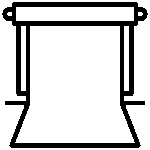 Backdrop & Support Kit
Backdrop & Support Kit Battery & Charger
Battery & Charger Camera Bags
Camera Bags
